You can ask just about anyone who grew up in Wheeling about how they spent their winter weekends from childhood through adolescence, and they will likely have the same response: ice skating at Wheeling Park. It was the place to be all weekend long. Not only did young people meet their friends at the rink, but many of them found romance on the crowded ice, too.
In fact, in as late as the early 1990s, Nat Goudy, manager of operations of the Wheeling Park Memorial Ice Skating Rink, recalls between 800 and 900 people on the ice on winter weekends.
But long before the rink opened to the public in 1959, the people of the Ohio Valley — and in cold climates around the world — couldn’t get enough of gliding on ice. In fact, the history of skating itself involves a fascinating mixture of climate change, technology and community.
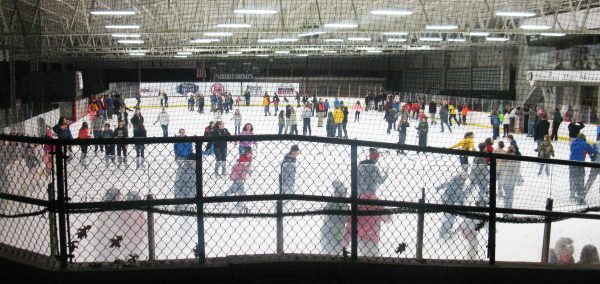
HOW IT ALL BEGAN
No one knows the exact date when ice skating began, but historians and archaeologists have uncovered enough clues to argue that over 4,000 year ago humans began skating on the ice in Finland and other parts of Europe. Unlike the fun activity it would later become, ice skating came about as a means for navigating lakes and other frozen bodies of water to make travel in cold climates less harrowing and time consuming.
A pair of skates dated to around 3,000 B.C.E. was found at the bottom of a lake in Switzerland. Like other skates of the era, they were made out of leg bones of large animals and affixed to the foot. These were the first skates used by humans.
Later, skates would be made out of metal, but they weren’t sharpened until around the 14th century when the Dutch began adding an edge to blades so that skaters could cut the ice and perform the intricate footwork ice skating fans cheer for today.
LAKES, PONDS, RIVERS AND STREAMS
According to an article by Kevin Ambrose in The Washington Post, ice skating became popular in the United States in the years leading up to the Civil War and the years after “due to a long string of cold winters in the Northern Hemisphere and improvements in the design of ice skate blades and footwear.” These cold winters ensured that the water in local bodies of water, including lakes, ponds, rivers and streams, froze harder and stayed that way longer than usual. Thus, a national pastime was created that encouraged men, women and children to come together for outdoor fun.
Up until the early 1980s, Ohio Valleyians recall skating on frozen bodies of water locally, including parts of Wheeling Creek. In fact, signs warning of thin ice can still be found at local ponds and lakes, even though they are usually not frozen hard enough or long enough for skaters to even make an attempt to traverse most of them today.
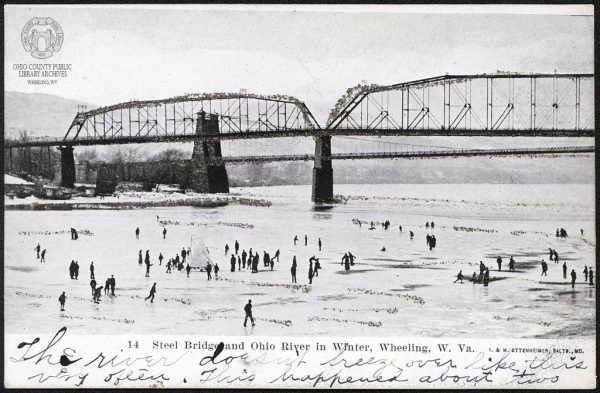
Interestingly enough artifacts found at the bottom of bodies of water and historical diaries reveal that Civil War soldiers ice skated both for necessity and enjoyment during the war between the states. Imagine trying to sleep in a tent when the temperature is cold enough to freeze water thick enough for skating.
Meanwhile, skating enthusiasts in Europe were trying to figure out how to extend ice skating year ’round. Although not the first rink of its kind, the Glaciarium in London, England, was the largest at over 3,000 square feet. Tim Jepson and Larry Porges write in the National Geographic London Book of Lists that it was a grand rink with bands accompanying skaters as they whizzed around the man-made lake, which opened in 1844.
Soon, this no-freeze rink concept spread across the world where New Yorkers and other big-city dwellers skated in their Sunday-go-to-meetin’ clothes. Unfortunately, the fun did not last long. These artificial rinks reeked. Because refrigeration of the kind needed to preserve an ice skating rink did not exist at the time, inventors created a hardened, slick surface out of salts, sulphate of copper and hog’s lard.
As Jepson and Porges note, “The appalling smell of the substitute would be the project’s undoing.” Imagine, too, that falling in your best clothing, which is what people of all social classes wore while skating at public spots, would end in disaster as pig fat would easily stain clothing.
DASHING ALL THE WAY
Thankfully, inventors went back to their drawing boards and were able to create indoor rinks made of ice. One of the better-known rinks opened in 1876 by inventor and veterinarian James Gamgee in a tent off the side of King’s Road in London. According to Zoe Craig in an article in the Londonist, “Gamgee’s rink was based on a concrete surface, with layers of earth, cow hair and timber planks.” On top of those layers, he added copper pipes filled with glycerine, ether, nitrogen peroxide and water. When water was dumped over the pipes, it froze and created a skating surface.
Unfortunately, it worked a bit too well. According to Craig, “The ice was just too cold.” But avid skaters did not let the freezing mist keep them away. Gamgee’s rink was a popular destination for more than a decade before new, better methods of creating artificial rinks were developed.
Meanwhile, ice skates, skating fashions and moves were transforming. After abandoning the use of animal bones, metal skates were invented. They were flat, though, and slid across the ice, which made it impossible to do much more than go forward or backward. In 1865, Jackson Haines, an American known as the father of modern figure skating, created a two-plate, all-metal blade that he attached to his boots. He was able to add ballet and dance moves to his routines, which made ice skating even more sensational. In the 1870s he added toe picks to skates, which allowed skaters to jump and twirl for the first time. All done, of course, in the highest ice skating fashions of the day.
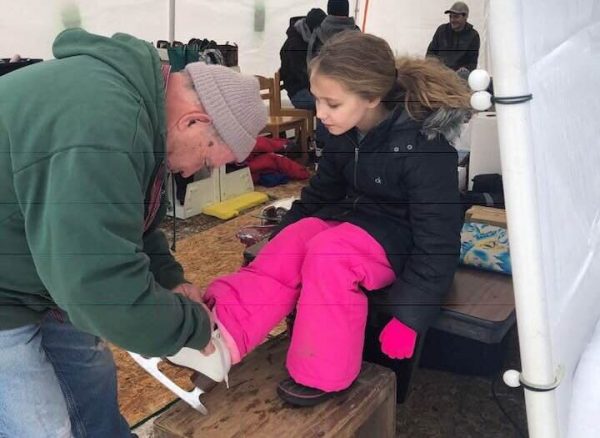
CLUBS AND COMPETITIONS
The world’s first known skating club, the Edinburgh Skating Club, was formed in 1742, and the first ice skating how-to book was published in 1772. It was written by a British army officer to illustrate various figure skating basics, such as circles and figure eights. Its publication led to the division of ice skating into speed skating and figure skating.
As is typical with most human endeavors, ice skating competitions were created and attracted large crowds of spectators. The first speed skating event was held in Norway in 1863. The first World Championships were held in the Netherlands in 1889 and included teams from the U.S., Russia, and England. Speed skating was added to the Olympic winter games in 1924.
Figure skating was soon to follow as the first European Championships were held in Germany in 1891 and five years later, the first World Championships were held in Saint Petersburg. A full 16 years before speed skating, figure skating became the first winter Olympic sport in 1908.
During those early years of the 20th century, the competitive world of figure skating was dominated by a Swedish skater named Ulrich Salchow. Not only did he win the world championships 10 times, but he also developed ice skates with serrated blades, which made long jumps possible. Still today the Salchow jump is used regularly in figure skating.
World War I put a halt to skating championship games, but in 1922 the World and European Championships re-opened. During this post WWI era, skaters like Norway’s Sonja Henie and Austria’s Karl Shafer ruled the ice.
The sport was interrupted once again in the 1940s by World War II and resumed in 1946. Because of the toll of the war on Europe, American and Canadian skaters dominated the scene until 1961 when the entire U.S. figure skating team and their coaches died in a plane crash in Belgium on their way to the World Figure Skating Championships in Prague, Czechoslovakia. Americans shied away from the sport after the tragedy, but figure skating would find itself back in the spotlight again in the late 1960s when American Peggy Fleming took center stage by bringing home the gold at the 1968 Winter Olympics.
It was during the heady days of the 1950s when U.S. figure skaters were dominating the sport that the Wheeling Park Memorial Ice Rink was opened on Dec. 26, 1959. Just six years later, Edward E. Wright would start the valley’s first skating club in 1965. The Wheeling Skating Club (WSC) earned full status in the U.S. Figure Skating Association (USFSA) two years later.
Over the years, several successful skaters got their start in the Wheeling Skating Club, including Bob Orr, a recently retired CBS broadcast journalist who began his reporting career at WTRF. Orr was an avid skater and member of the WSC during his years growing up in Wheeling. In addition, three former members of WSC went on to achieve success on the regional and international rinks. Leif Erikson, along with his skating partner, Amy Webster, finished eighth in the 1990 U.S. Figure Skating Championships Senior Division for Ice Dancing. Laurie Baker was a 1990 U.S. Junior World Team Member. Sarah Cammarata came in 11th place at the 2003 South Atlantic Regional Championships Junior Ladies, among other accomplishments.
Skaters from the Wheeling Skate Club, along with professionals and skaters from the Pittsburgh area, perform in the Wheeling Symphony’s Symphony on Ice at Wesbanco Arena. On Nov. 29, 2018, WSC skated alongside professional skaters, Ashley Wagner and Robbie Przepioski, to an assortment of holiday songs masterfully played by Wheeling Symphony.
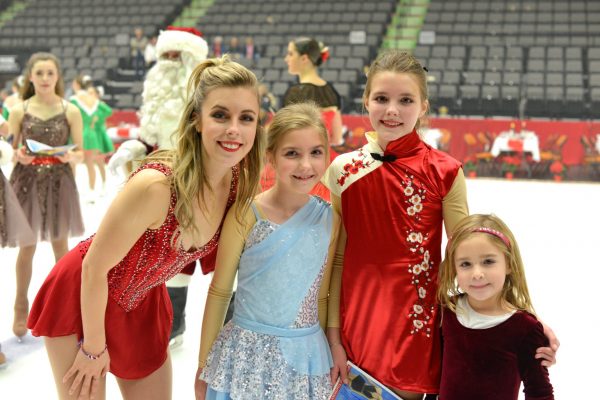
COMMUNITY SPIRIT
This season, the ice rink at Wheeling Park recorded more than 19,500 admissions for public skating with 300 season passes sold, according to Goudy. In addition to the dozens of members of the Wheeling Figure Skating Club and the Learn to Skate Program, hundreds of youth hockey players participate in the Wheeling Amateur Hockey Association programs. Hockey has been a popular winter sport in Wheeling for decades, but it has grown even more important since the Wheeling Nailers professional hockey team came to town in 1992.
Although the Wheeling Park Memorial Ice Rink is the region’s only true ice rink, pop-up rinks are common at festivals. Most of them, though, are created using synthetic ice, which is made of a slippery polymer that gives visitors the thrill of the skate without the chill of the ice. One spontaneous rink, however, stands out both for its natural environment and the community atmosphere it creates.
About an hour south of Wheeling skaters can slip and slide to their hearts’ content at the New Martinsville Marina Community Ice Rink. Danny Westfall started the rink about five years ago to give the children of the area a place to have some safe outdoor fun in the winter. According to a 2016 article in the Wetzel Chronicle, “The first year some water left behind from flooding naturally created the ice rink, but the past two years Westfall has worked to dam and flood a larger area south of Harlan Drive so it will freeze and create a community ice rink.”
As more families discovered the rink, Westfall and other community members joined together to make it a truly special place, which includes small fires for warming, hot cocoa and even grilled hot dogs on special afternoons. In addition to providing skates, Westfall (known from his bus driving days as Mr. Danny) has a stock of gloves, blankets, coats and hats for anyone who came unprepared to skate. And all he does and gives is for free.
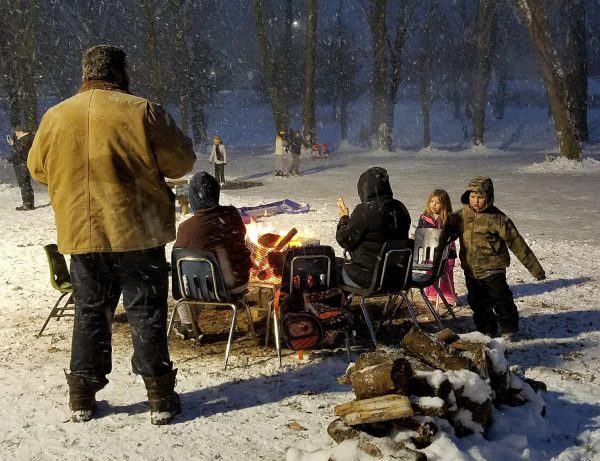
People have come from Moundsville, Wheeling, Marietta and elsewhere in the region to enjoy not just the excitement of skating on an outdoor rink, but for what feels like a moment from what some might call “the good old days” when small town friends and neighbors spent some time laughing together while zipping around the ice on a cold winter afternoon. New Martinsville resident Cherika Vaughn takes her two boys there often during the colder months. She says she is incredibly moved by Mr. Danny’s generosity. “Because it is free, he has helped a lot of people that do not have money for family night fun to take their families out and spend time together.”
And in the end, that is how ice skating has remained a popular activity for hundreds of years. It provides another way for humans to achieve what we need the most: each other.
• Christina Fisanick, Ph.D., is an associate professor of English at California University of Pennsylvania, where she teaches expository writing, creative non-fiction and digital storytelling. She is the author of more than 30 books, including her most recent memoir, “The Optimistic Food Addict: Recovering from Binge Eating Disorder.” She has been a Weelunk contributing writer since 2015. Christina is a 1996 graduate of West Liberty University and a member of Ohio Valley Writers. She lives in Wheeling with her family.


